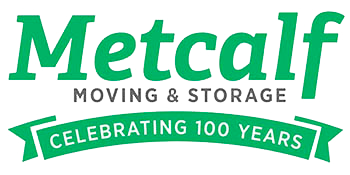METCALF MOVING BLOG
Pack Like a Pro for Your Household Move
Relocating your home is a challenging endeavor that requires careful attention to detail. Whether your relocation is sparked by a new career opportunity or a desire for change, thoughtful packing can ease complications and make settling into your new space much smoother. Here’s a comprehensive guide to help you pack effectively for your household move.
Tips for Packing Items in Boxes
The key to efficient packing lies in organization and strategic placement of items:
- Plan Your Packing Order: Start by packing items that you use infrequently. Save everyday essentials for last so that you have easy access to them during the move.
- Sort and Purge: Before packing, take the time to sort through your items and decide what you no longer need. Removing unnecessary clutter saves space and reduces the overall load.
- Use the Right Packing Techniques: Roll clothing instead of folding it to save space and reduce wrinkles. For books or small electronics, pack them flat to avoid pressure damage.
- Consider Weight Distribution: When packing items into a box, stack heavier items at the bottom and lighter ones on top. This not only prevents damage to fragile items but also makes the boxes easier to carry.
- Maintain a Consistent Method: Develop a system that works for you—whether it’s packing each room separately or grouping by item type—and stick to it. Consistency will help keep your inventory in order and make the unpacking process smoother.
Bonus tip: Pack an “essentials box” with things you’ll need immediately upon arrival at your new home. Include: toiletries, a change of clothes, basic kitchen utensils, and electronics chargers.
Packing a Standard Box
When it comes to standard boxes, start with these best practices to ensure your items are secure and neatly organized:
- Choose the Right Box: Select a box that is sturdy and appropriately sized for the contents. Avoid overloading large moving cartons with heavy items; instead, pack lighter items into them to prevent damage.
- Line the Box: Before adding your items, place a layer of crumpled packing paper or bubble wrap on the bottom of the box. This extra cushioning acts as a buffer, protecting your belongings from impact.
- Organize Items by Category: Group like items together before placing them into the box. For instance, pack all your books in one box or kitchen utensils in another. This categorization not only makes packing more methodical but also simplifies unpacking later on.
- Fill in Gaps: Once your items are in the box, fill any gaps with crumpled paper, packing peanuts, or additional bubble wrap to ensure a secure fit. This helps prevent the items from shifting during transit.
- Seal and Label: Use high-quality packing tape to close the box securely. Then, clearly label the box on multiple sides with its contents and the room it belongs to in your new home. Labels should be legible and should cleacate if the box contains any fragile items.
How to Pack Small, Fragile Items in a Box
To prevent damage during a move, small, fragile items require special care:
- Wrap Each Item Individually: Use bubble wrap, packing paper, or a soft cloth to wrap small, fragile items, such as glassware, then eramics, or ornaments. Secure the wrapping with a small piece of tape if necessary.
- Use Dividers: For particularly delicate items, consider using cardboard dividers or custom-cut foam inserts to provide an extra layer of protection within the box.
- Double Box for Extra Protection: For very fragile items, consider placing the wrapped item in a smaller box first, then put that box inside a larger one with extra cushioning materials. This creates an additional barrier between your items and any external impacts.
- Mark the Box: Label boxes containing fragile items with a bold “Fragile” sticker or marking on multiple sides. Ensure that everyone handling the box is aware that its contents require careful handling and attention to detail.
- Avoid Overpacking: Do not overload fragile boxes with too many items; give each piece enough space to minimize pressure and movement.
Putting It All Together
Efficient packing is more than just a series of steps—it’s a carefully planned process that requires attention to detail at every stage. From decluttering your home to selecting the right packing materials and following specific methods for different types of items, the effort you invest in packing effectively will pay dividends when you unpack.
Maintaining organization throughout your move reduces stress and helps preserve the condition of your belongings. It also enables you to locate items quickly in your new space, ensuring a smoother transition and a faster return to your home’s routine.
Smooth Moves Start with Smart Packing
The key to a successful household relocation is packing efficiently. Our expert team is ready to assist you with professional moving help tailored to your needs. Contact us today for reliable, efficient support that makes your transition as seamless as possible.












